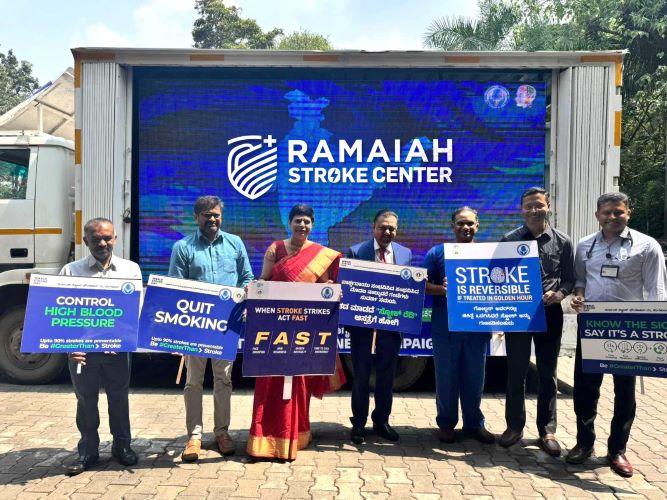Team L&M
Ramaiah Memorial Hospital has launched its Ramaiah Stroke Center, a state-of-the-art, comprehensive, multi-disciplinary 24/7 stroke management unit with a Neurointensive Care Unit within its hospital premises.
Stroke is the third leading cause of death and the sixth leading cause of disability in India. Also referred to as a brain attack, a stroke can happen to anyone at any time. However, the effects of stroke are not similar for everyone and are based on the severity and the number of strokes that the person suffers. Depending on the earliest signs of stroke, the effects and the damages caused are determined and it is, therefore, crucial to get immediate treatment. While reaching the nearby hospital within the Golden Hour (4.5 hours from the time of stroke) may save the affected person’s life, a comprehensive stroke center ensures that the patient is given the right treatment from the moment he arrives and is completely cured and back on his feet.
Sharing his opinion on the necessity of setting up a comprehensive stroke center in the neighborhood, Dr SC Nagendra Swamy, President – Ramaiah Memorial Hospital said, “The incidence of stroke is on the rise in our country at 138 per 100,000 population. A recent research study by The Lancet South East Asia revealed the need for an immediate and long-term stroke surveillance framework to address the increasing burden of stroke in India. The quintessential challenge, however, remains that of setting up a comprehensive stroke care center that is easily accessible in times of emergency. I am pleased that, we at Ramaiah Memorial Hospital are announcing the launch of our multidisciplinary, all-encompassing Ramaiah Stroke Centre that is designed to run 24/7 and cater to every patient suffering a stroke and ensure that, at every step the patient will be protected and taken care of with utmost precautionary measures.”
The purpose of Ramaiah Stroke Center is to ensure that every incidence of death and disability due to stroke is profoundly reduced through the specialized multidisciplinary approach of timely diagnosis, administering immediate treatments through medical and surgical interventions as needed, thereby preventing complications, rehabilitation, and secondary prevention. A dedicated six-bed Stroke ICU has been set up within the Neuro ICU to ensure that every stroke patient can benefit from the highest standard of clinical and rehabilitation care provided.
Explaining the importance of following the Stroke Code Protocol in the event of treating a stroke, Dr Aruna D Ramesh, HOD & Senior Consultant – Department of Accident & Emergency, Ramaiah Memorial Hospital, said, “When it comes to stroke management, the Stroke Code protocol is initiated within the Golden Window Period of 4.5 hours when a patient is suspected of having a stroke. We follow the recommended standards of stroke care of 8 Ds of the Stroke Code including Detection (recognition of symptoms at their early onset), Dispatch (rapidly calling emergency services to transport the patient to a medical facility with pre-notification), Delivery (ensuring that the patient is delivered to the Ramaiah Stroke Center wherein the stroke team is alerted and kept ready), Door (time taken for the patient to arrive at the hospital and get the rapid response team to quickly assess the patient using neurological assessment mechanism to determine the type and severity of the stroke), Diagnosis (quickly gathering necessary medical information and performing imaging tests like CT scan to confirm the type of stroke), Decision (making swift decisions about the best treatment options based on the type of stroke), Drug (administering appropriate medications) and Disposition (plan the next steps after initial treatment).
Emphasising how neuro-interventions and nuero-surgical procedures play a significant role in comprehensive stroke centers, Dr. Sunil V Furtado, HOD & Senior Consultant – Department of Neurosurgery, Ramaiah Institute of Neurosciences, Ramaiah Memorial Hospital shared, “There are instances wherein many of the patients are not the candidates for only clot-busting drugs and may need emergency surgery to treat blocked or bleeding brain blood vessels. After the initial tests (such as a CT angiogram) are performed, the results may show a clot inside an artery, blocking blood flow to the brain. In such cases, we use special devices to emergently open these brain arteries, restore blood flow to the brain, and reverse the cause of stroke, thereby giving patients the best chance of recovery.”
